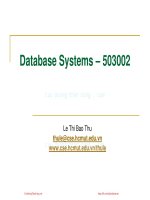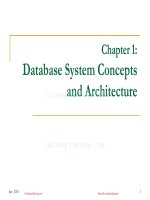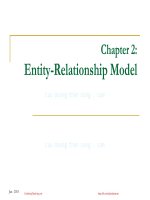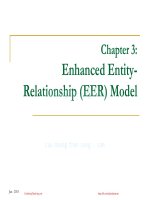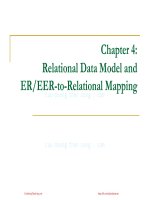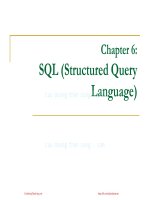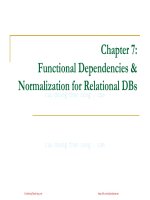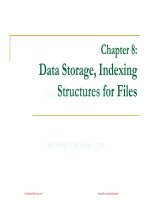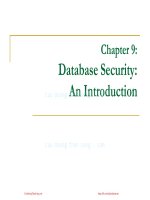cơ sở dữ liệu lê thị bảo thu chương ter 09 database security sinhvienzone com
Bạn đang xem bản rút gọn của tài liệu. Xem và tải ngay bản đầy đủ của tài liệu tại đây (1.64 MB, 83 trang )
Chapter 9:
Database Security:
An Introduction
CuuDuongThanCong.com
/>
Contents
1
Introduction to Database Security Issues
2
Discretionary Access Control (DAC)
3
Mandatory Access Control (MAC)
4
Role-Based Access Control (RBAC)
5
Encryption & PKI (Public Key Infrastructure)
Jan - 2015
CuuDuongThanCong.com
/>
Contents
1
Introduction to Database Security Issues
2
Discretionary Access Control (DAC)
3
Mandatory Access Control (MAC)
4
Role-Based Access Control (RBAC)
5
Encryption & PKI (Public Key Infrastructure)
Jan - 2015
CuuDuongThanCong.com
/>
Introduction to Database Security
Issues (1)
Types of Security:
Jan - 2015
Legal and ethical issues
Policy issues
System-related issues
The need to identify multiple security levels
CuuDuongThanCong.com
/>
Introduction to Database Security
Issues (2)
Three Basic Concepts:
Jan - 2015
Authentication: a mechanism that determines
whether a user is who he or she claims to be.
Authorization: the granting of a right or privilege,
which enables a subject to legitimately have
access to a system or a system’s objects.
Access Control: a security mechanism (of a
DBMS) for restricting access to a system’s objects
(the database) as a whole.
CuuDuongThanCong.com
/>
5
Introduction to Database Security
Issue (3)
Threats:
Any situation or event, whether intentional or
unintentional, that will adversely affect a system
and consequently an organization.
Threats to:
Jan - 2015
Computer systems
Databases
CuuDuongThanCong.com
/>
Threats to
Computer
Systems
Jan - 2015
CuuDuongThanCong.com
/>
Scope of Data Security Needs
Must protect databases & the servers on which they
reside.
Must administer & protect the rights of internal database
users.
Must guarantee the confidentiality of ecommerce
customers as they access the database.
With the Internet continually growing, the threat to data
traveling over the network increases exponentially.
Jan - 2015
CuuDuongThanCong.com
/>
Introduction to Database Security
Issues (4)
Threats to databases:
Loss of integrity
Loss of availability
Loss of confidentiality
To protect databases against these types of threats four
kinds of countermeasures can be implemented:
Jan - 2015
Access control
Inference control
Flow control
Encryption
CuuDuongThanCong.com
/>
Introduction to Database Security
Issues (5)
A DBMS typically includes a database
security and authorization subsystem that is
responsible for ensuring the security portions
of a database against unauthorized access.
Two types of database security mechanisms:
Jan - 2015
Discretionary security mechanisms
Mandatory security mechanisms
CuuDuongThanCong.com
/>
Introduction to Database Security
Issues (6)
The security mechanism of a DBMS must
include provisions for restricting access to the
database as a whole
Jan - 2015
This function is called access control and is
handled by creating user accounts and passwords
to control login process by the DBMS.
CuuDuongThanCong.com
/>
Introduction to Database Security
Issues (7)
The security problem associated with
databases is that of controlling the access to
a statistical database, which is used to
provide statistical information or summaries
of values based on various criteria.
Jan - 2015
The countermeasures to statistical database
security problem is called inference control
measures.
CuuDuongThanCong.com
/>
Introduction to Database Security
Issues (8)
Another security is that of flow control,
which prevents information from flowing in
such a way that it reaches unauthorized
users.
Channels that are pathways for information to
flow implicitly in ways that violate the security
policy of an organization are called covert
channels.
Jan - 2015
CuuDuongThanCong.com
/>
Introduction to Database Security
Issues (9)
A final security issue is data encryption, which
is used to protect sensitive data (such as credit
card numbers) that is being transmitted via some
type communication network.
The data is encoded using some encoding
algorithm.
Jan - 2015
An unauthorized user who access encoded data will
have difficulty deciphering it, but authorized users are
given decoding or decrypting algorithms (or keys) to
decipher data.
CuuDuongThanCong.com
/>
Database Security and the DBA (1)
The database administrator (DBA) is the
central authority for managing a database
system.
The DBA’s responsibilities include:
granting privileges to users who need to use the system.
phu hop
classifying users and data in accordance with the policy
of the organization.
The DBA is responsible for the overall
security of the database system.
Jan - 2015
CuuDuongThanCong.com
/>
Database Security and the DBA (2)
The DBA has a DBA account in the DBMS:
Jan - 2015
Sometimes these are called a system or superuser
account.
These accounts provide powerful capabilities such as:
1. Account creation
2. Privilege granting
3. Privilege revocation
4. Security level assignment
Action 1 is access control, whereas 2 and 3 are
discretionary and 4 is used to control mandatory
authorization.
CuuDuongThanCong.com
/>
Access Protection, User Accounts,
and Database Audits (1)
Whenever a person or group of persons need
to access a database system, the individual
or group must first apply for a user account.
The DBA will then create a new account id and
password for the user if he/she deems there is a
legitimate need to access the database.
The user must log in to the DBMS by entering
account id and password whenever database
access is needed.
Jan - 2015
CuuDuongThanCong.com
/>
Access Protection, User Accounts,
and Database Audits (2)
theo doi
The database system must also keep track
of all operations on the database that are
applied by a certain user throughout each
login session.
Jan - 2015
To keep a record of all updates applied to the
database and of the particular user who applied
each update, we can modify system log, which
includes an entry for each operation applied to the
database that may be required for recovery from a
transaction failure or system crash.
CuuDuongThanCong.com
/>
Access Protection, User Accounts,
and Database
Audits
(3)
gia mao
If any tampering with the database is
nghi ngo
suspected, a database audit is performed.
A database audit consists of reviewing the log to
examine all accesses and operations applied to
the database during a certain time period.
A database log that is used mainly for
security purposes is sometimes called an
audit trail.
Jan - 2015
CuuDuongThanCong.com
/>
Contents
1
Introduction to Database Security Issues
2
Discretionary Access Control (DAC)
3
Mandatory Access Control (MAC)
4
Role-Based Access Control (RBAC)
5
Encryption & PKI (Public Key Infrastructure)
Jan - 2015
CuuDuongThanCong.com
/>
Discretionary Access Control (DAC)
User can protect what they own.
Owner may grant access to other.
Owner can define the type of access
(read/write/execute/…) given to others.
The typical method of enforcing
discretionary access control in a database
system is based on the granting and
revoking privileges.
Jan - 2015
CuuDuongThanCong.com
/>
Types of Discretionary Privileges (1)
The account level:
At this level, the DBA specifies the particular
privileges that each account holds independently
of the relations in the database.
The relation level (or table level):
Jan - 2015
At this level, the DBA can control the privilege to
access each individual relation or view in the
database.
CuuDuongThanCong.com
/>
Types of Discretionary Privileges (2)
The privileges at the account level apply to the
capabilities provided to the account itself and can
include:
Jan - 2015
the CREATE SCHEMA or CREATE TABLE privilege, to
create a schema or base relation;
the CREATE VIEW privilege;
the ALTER privilege, to apply schema changes such
adding or removing attributes from relations;
the DROP privilege, to delete relations or views;
the MODIFY privilege, to insert, delete, or update tuples;
and the SELECT privilege, to retrieve information from the
database by using a SELECT query.
CuuDuongThanCong.com
/>
Types of Discretionary Privileges (3)
The second level of privileges applies to the relation
level
This includes base relations and virtual (view) relations.
In SQL the following types of privileges can be granted
on each individual relation R:
Jan - 2015
SELECT (retrieval or read) privilege on R:
This gives the account retrieval privilege.
The SELECT statement is used to retrieve tuples from
R.
REFERENCES privilege on R:
This gives the account the capability to reference
relation R when specifying integrity constraints.
The privilege can also be restricted to specific attributes
of R.
CuuDuongThanCong.com
/>
Types of Discretionary Privileges (4)
In SQL the following types of privileges can be granted
on each individual relation R (contd.):
MODIFY privileges on R:
This gives the account the capability to modify tuples of
R.
In SQL this privilege is further divided into UPDATE,
DELETE, and INSERT privileges to apply the
corresponding SQL command to R.
In addition, both the INSERT and UPDATE privileges
can specify that only certain attributes can be updated by
the account.
Notice that to create a view, the account must have
SELECT privilege on all relations involved in the view
definition.
Jan - 2015
CuuDuongThanCong.com
/>
